Niraj what makes Jivdhan fort special ? Along with the historical significance Jivdhan fort still has many water tanks , entrance structures , rock -cut stairs, caves, buildings intact inspite of centuries of neglect. What catches my attention is the adventurous climb over the broken stairs which now resemble a rock patch with a waterfall gushing over it. In this Jivdhan fort trek blog you will find all the information to plan this trek yourself . Similar adventures like this one & more things to do around Malshej ghat & near by are mentioned at the end of the post
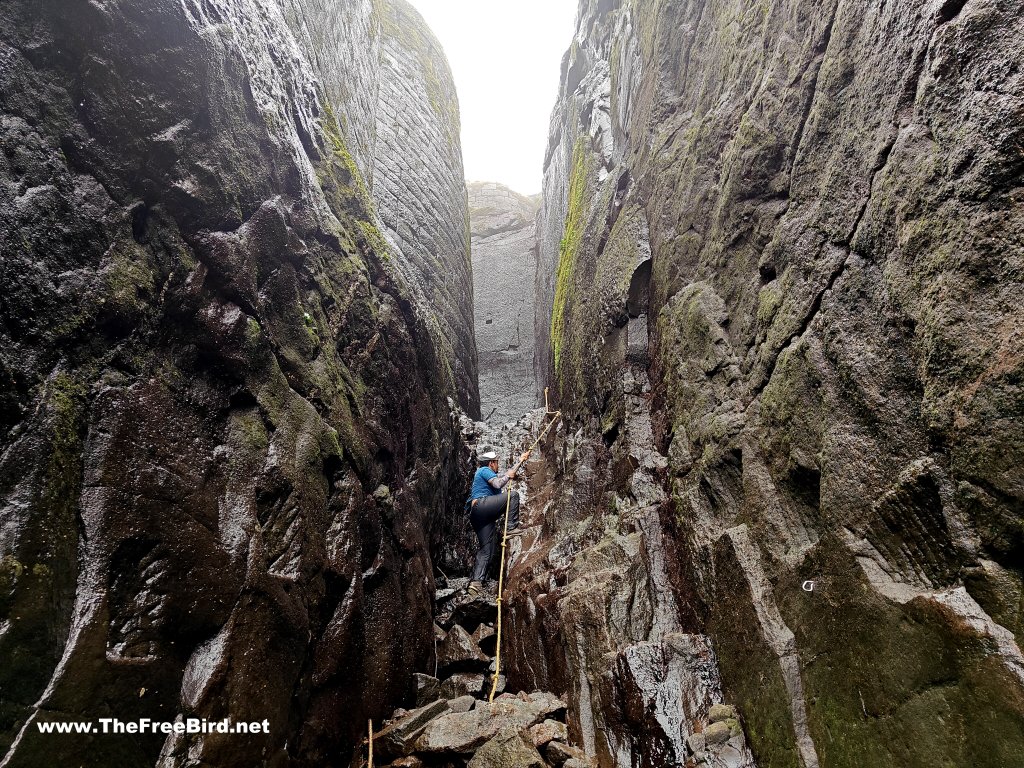
Is Jivdhan fort Trek difficult for beginners ?
Niraj, how difficult is Jivdhan fort trek for beginners? Jivdhan fort trail is a short one , however the climb from either side of the fort – Kalyan darwaja & Junnar darwaja involves climbing over broken stairs which are at places completely blown off by British. Such rock patches are difficult to climb for beginners , but a regular trekker can climb them with the help of rope which is tied there by locals. In monsoon there is water flowing over stairs making it slippery& even more risky. However metal railing are now installed here which is of great help during the climb. Thus the only thing difficult is the rock patch – one at entrance of Kalyan darwaja route & another one in middle of the Junnar darwaja route. However beginners can still climb it with the assistance of other trekkers. Though the rock patch of Kalyan darwaja is difficult , the rock patch of Junnar route is much more polished and slippery, hence the Kalyan route is slightly easier than Junnar route.
How long is the Jivdhan fort trek ?
How much time does it take to complete Jivdhan fort trek ? From either side it will take about 90-120 minutes to climb the fort & another 90-120 minutes to go around the fort. North side has lesser remains but more walk hence would need another hour to cover. I didnt cover it since clouds had blocked visibility and made no sense to go there.
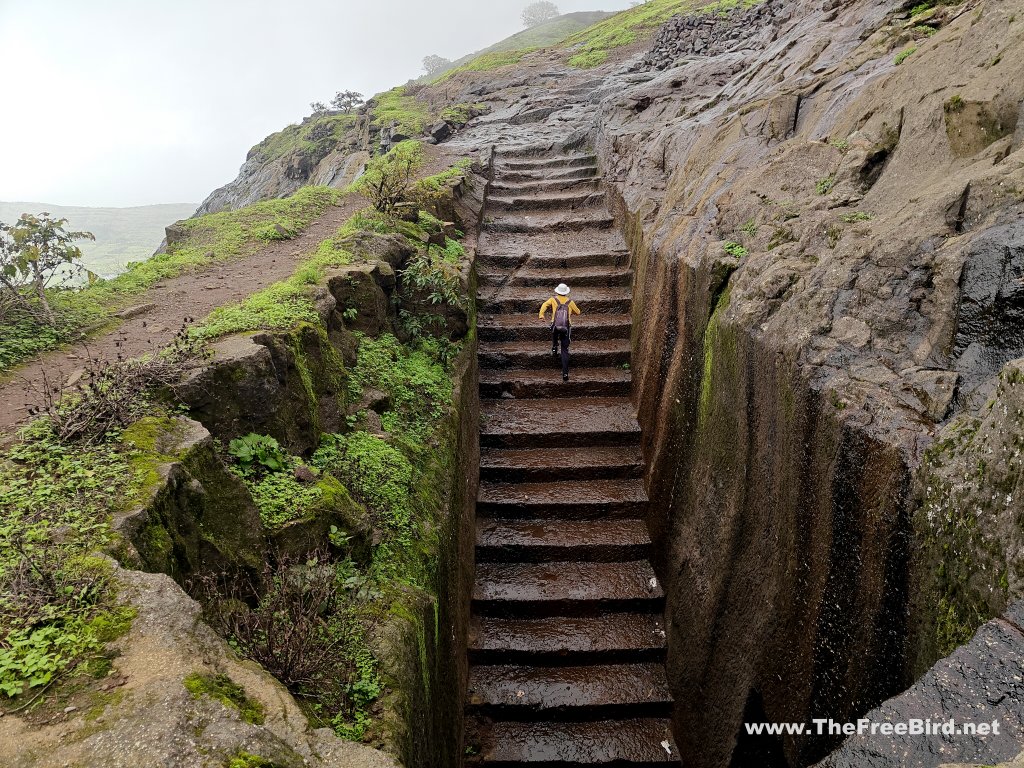
What is the best time for Jivdhan fort Trek ?
Jivdhan fort has tremendous views of various forts from AMK, Ratangad, Harishchandragad, Nimgiri, Sindola, Hadsar , Chawand, Gorakhgad & Machchhindragad and various hills like Ahupe, Dhakoba, Bigarya, vandev, chaurya, bhojgiri, ghonya , udhlya and many more . But this requires clear weather & the best time to enjoy it would be post -monsoon . Winter and summer would be provide visibility but the dust in atmosphere reduces visibility but is much better than monsoon. Monsoon on the other hand has its own charm when you get to enjoy Naneghat’s reverse waterfall which is at the base of Jivdhan fort & you have water flowing over stairs.
Jivdhan fort trek History
Naneghat trade route was well established during Satavahana’s time. To protect this flourishing trade route many forts like Jivdhan, Nimgiri , Hadsar, Chawand , Shivneri were created around Junnar. Apart from protection Jivdhan fort might have been used for stays during longer journeys by travellers. The last emperor of Adilshahi of Ahmednagar was little Murtaza. He was kept as a prisoner by the Mughals at Jivdhan fort. In 1635 the father of Shivaji, Shahaji released him from the prison and declared him a King of Ahmednagar. Jivdhan changed ownership through Mughals , Marathas & finally British – which seized control in 1818 and blew off the beautiful stairs & destroyed other structures.
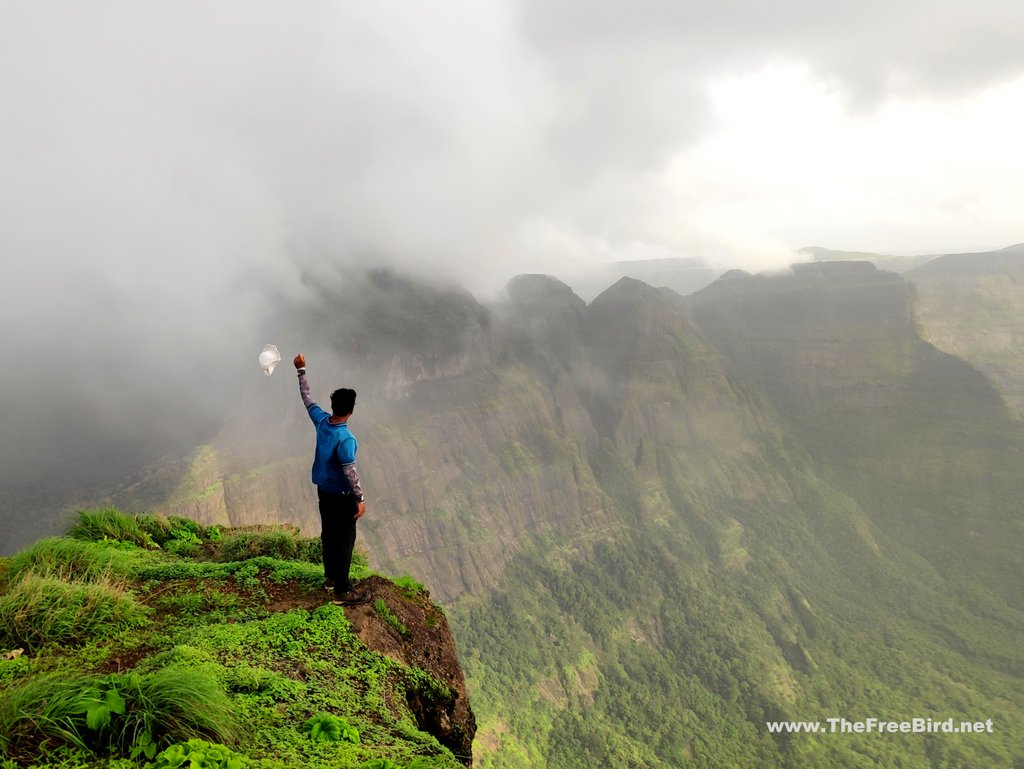
Where can we stay for Jivdhan fort ?
Ghatghar village , the base village of Jivdhan has many new homestays coming up owing to the viral popularity of the Naneghat reverse waterfall. Earlier there were only 1/2 stay options but now you will find plenty in this upcoming travel hub. From Naneghat being trading hub to travel hub things have changed. You will also find plenty of hotels and food stalls – esp on monsoon weekends. You wont get anything on the fort so plan accordingly. There are many water streams in monsoon which provide the tastiest, cold water full of natural minerals. I make it a point whenever I go for a trek to carry back this water home as this has many health benefits.
How to reach Jivdhan fort from Mumbai & Pune?
Where is Jivdhan located? Jivdhan fort lies in Junnar, Pune district and is about 120 kms from Pune city & 165 kms from Mumbai with Kalyan being the nearest big railway station.
From Pune: You can take any bus from Pune to reach Junnar and take another bus to Ghatghar village. Junnar darwaja route starts from Ghatghar village. You can either start trek through Junnar darwaja or head to Naneghat trade route some 10 minutes away from Ghatghar , then head to reverse waterfall and then climb Jivdhan via Kalyan darwaja. For private vehicle just use google maps to reach here.
From Mumbai: There are two ways to do it, you can either reach Ghatghar via public transport mentioned above or you can do it as part of a bigger trek wherein you climb the entire Naneghat trade route trek from Konkan/ kalyan side and once on top of Naneghat you can walk towards Jivdhan fort. I prefer the Naneghat trek route which spans about 25kms walking distance . How to plan Naneghat ? you will find that in my Naneghat blog. If you want to just do the Jivdhan trek then you can take Junnar bus from Mumbai side & then take another bus to Ghatghar villlage.
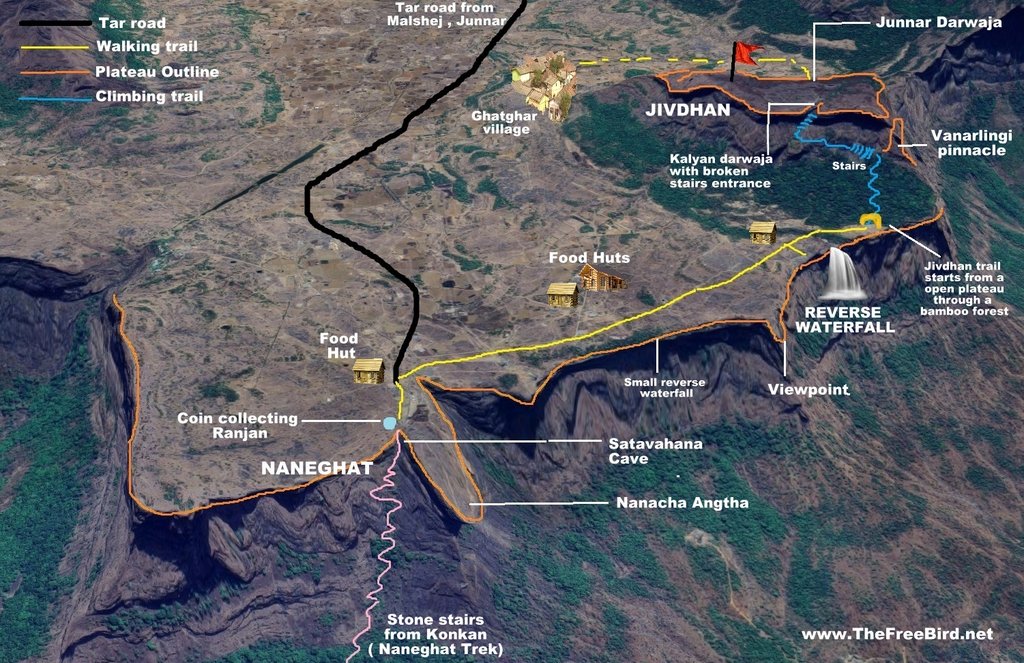
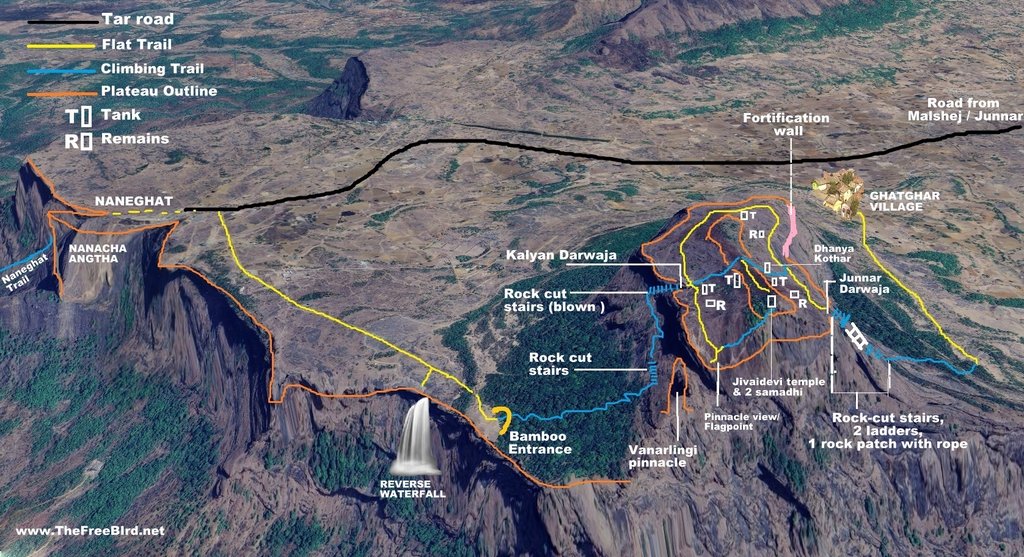
Jivdhan fort trek blog: TheFreeBird’s story
I had already climbed Naneghat trade route in about 3hours & explored the Satavahana caves, Nanacha Angtha & then headed towards Jivdhan fort. The climb was tiring and to energise myself I headed to the reverse waterfall enroute. Strong Konkan winds are blocked by the western ghats and they tend to concentrate at some places, such strong winds deflect the waterfall to the sky which makes for a spectacular view. You can read about it my Naneghat blog.
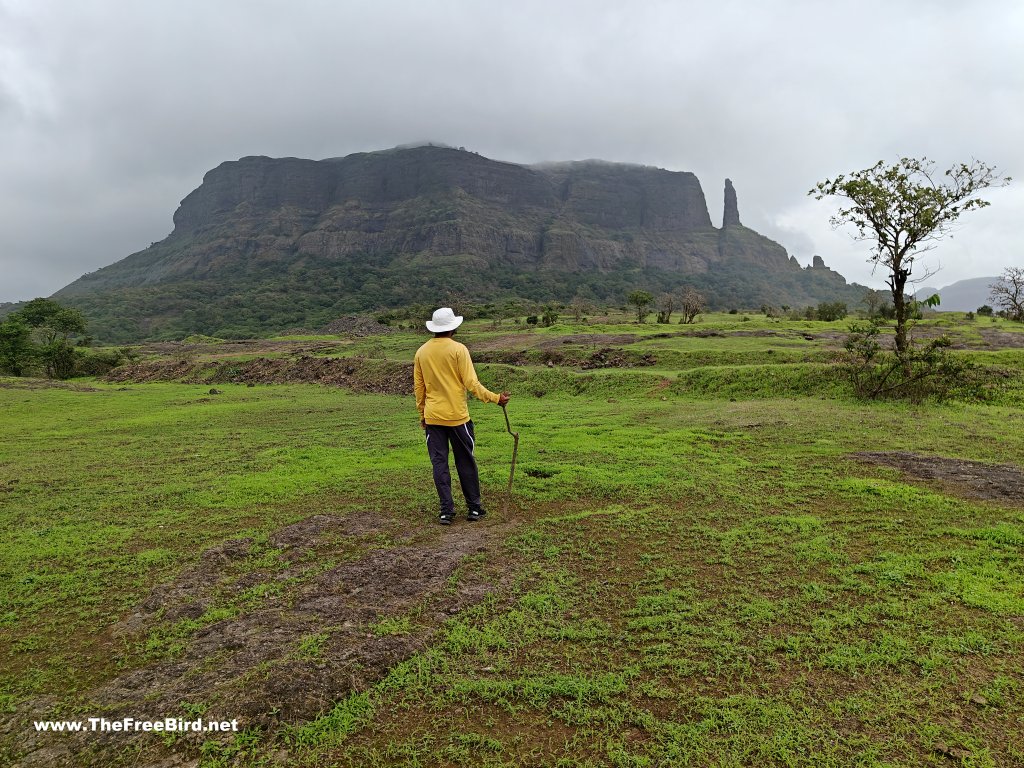
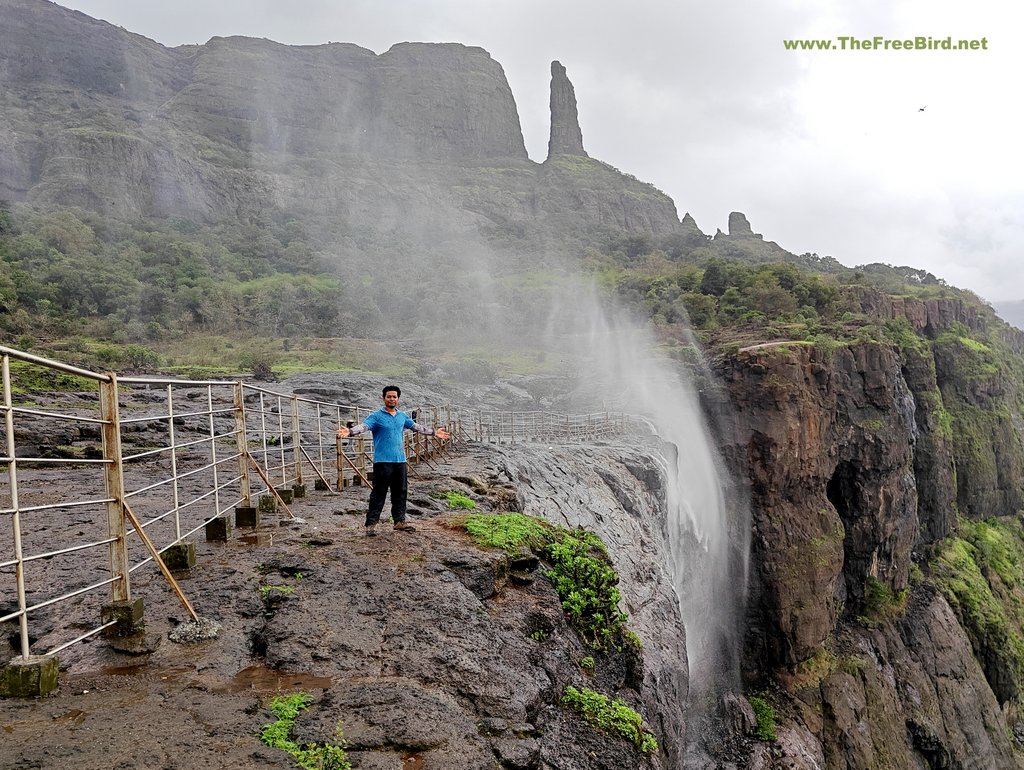
Though I didnt have extra clothes reverse waterfall was too much of lure to stay dry. Within seconds I was completely drenched & then started towards Jivdhan. If you walk by the edge of this plateau you pass through a small forest to reach a empty plateau with a bamboo forest on the left. There is a opening in this forest which is perfectly arched by bamboo . From here the trail passes through a jungle over rough stone stairs till we get out of the jungle near the Vanarlingi sulka.
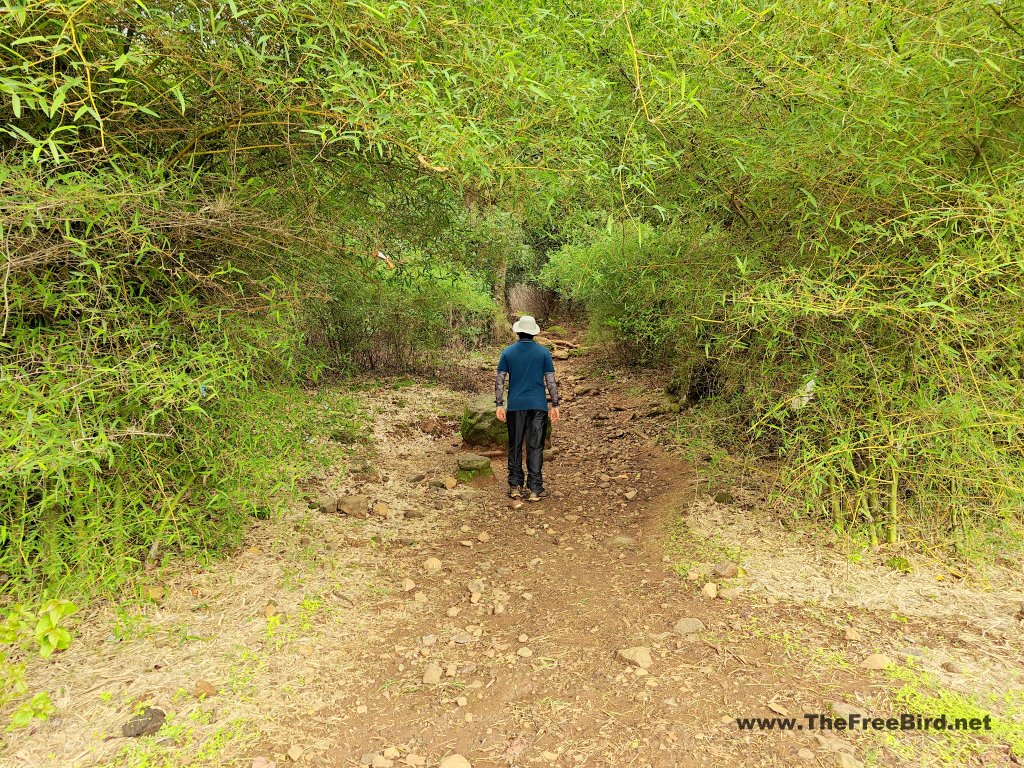
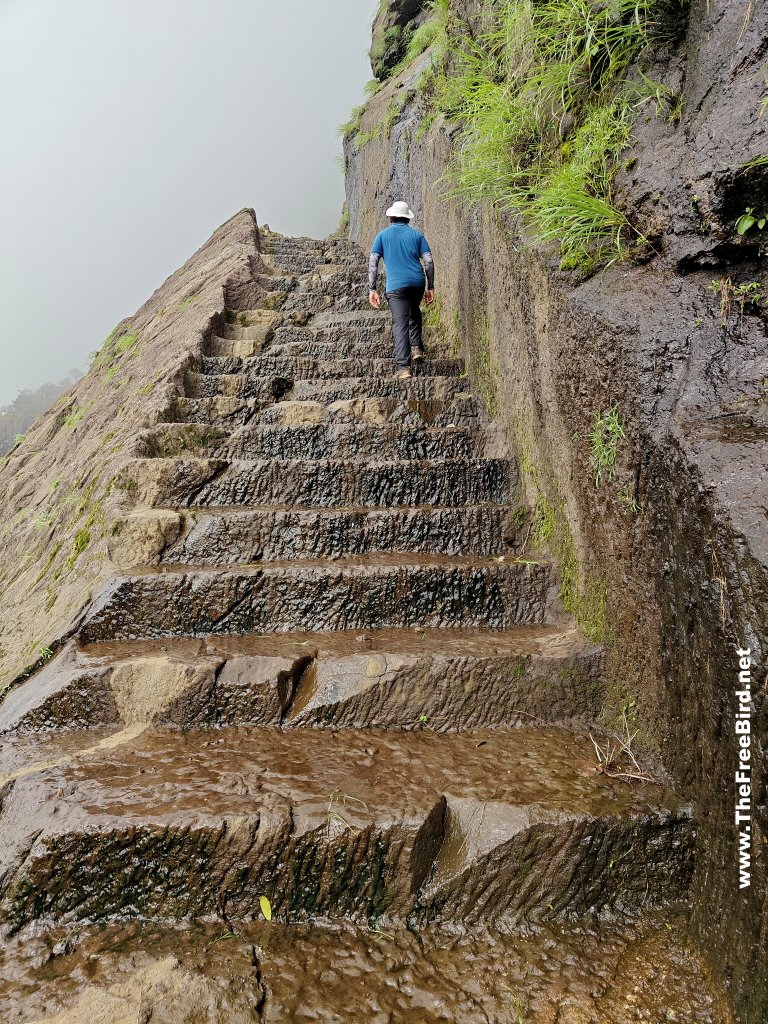
Jivdhan was under a cloud siege and after some time the pinnacle made an appearance
Coming out of this forest cover we reach the rock cut stairs one left side & trail to Vanarlingi sulka on right.
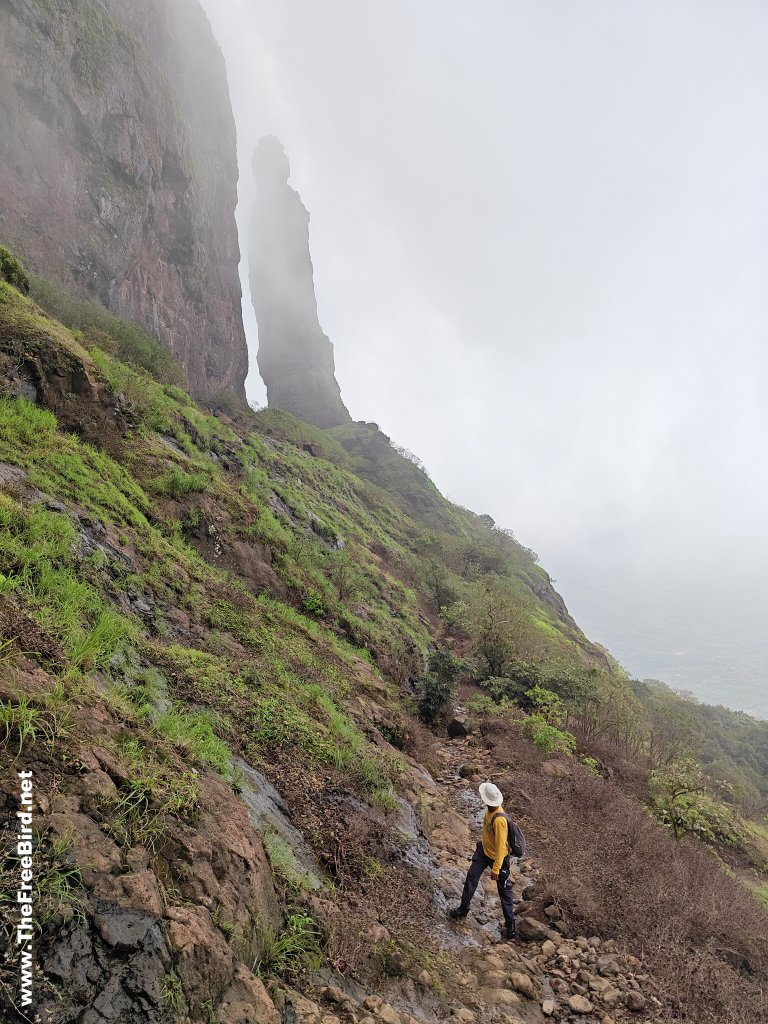
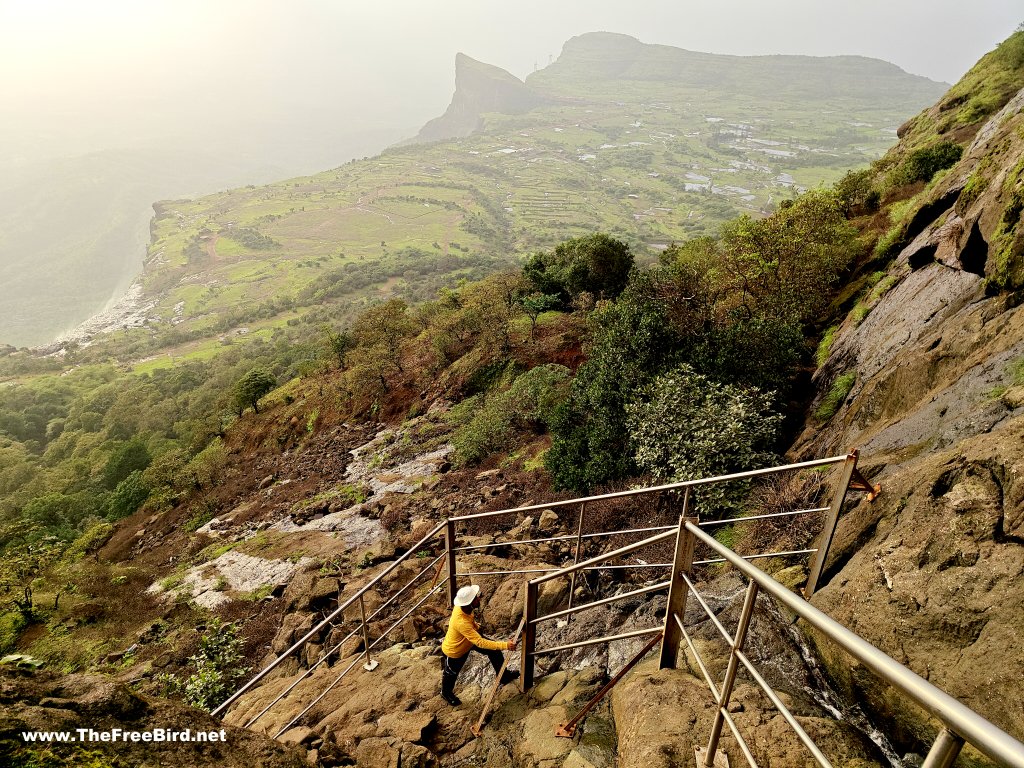
Soon we reached the rock cut stairs which have just been recently provided with metal railing. These stairs are covered in waterfall in heavy rains as a result the edges of these stairs have eroded and make for a slippery climb. The railing is definitely helpful during heavy rains. Apart from the natural erosion , the middle section of these stairs have been completely blown of by British in 1818 resulting a climb through big stones which may seem difficult but is actually a normal climb since over the years the blown off stones have settled in their respective spaces.
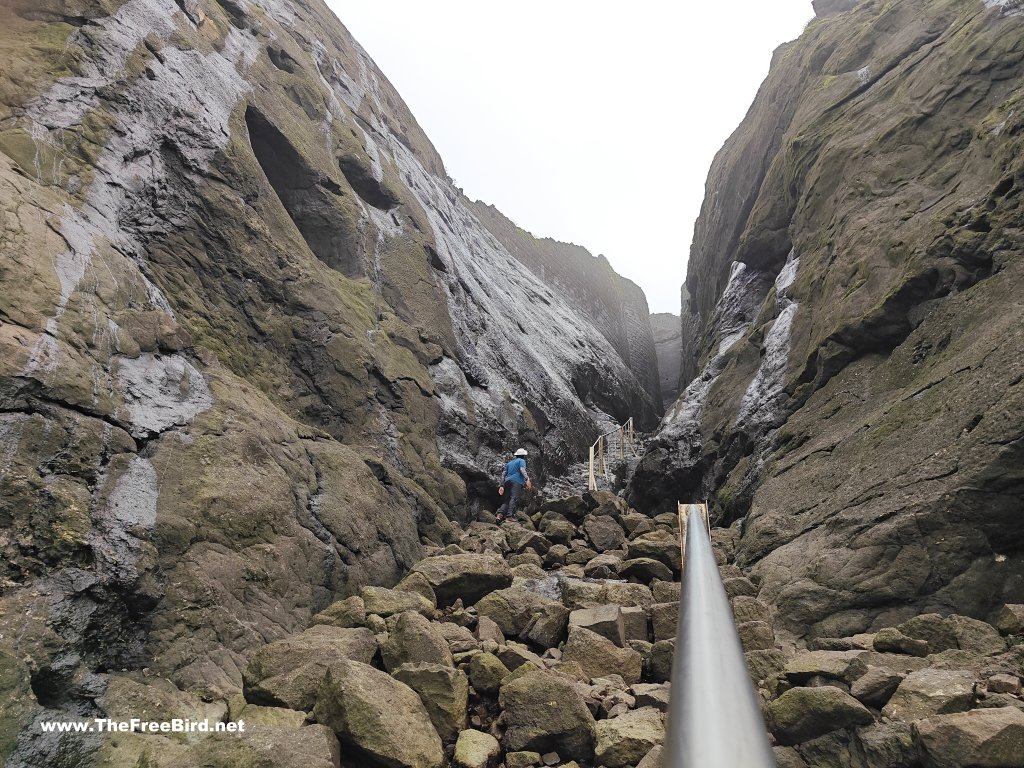
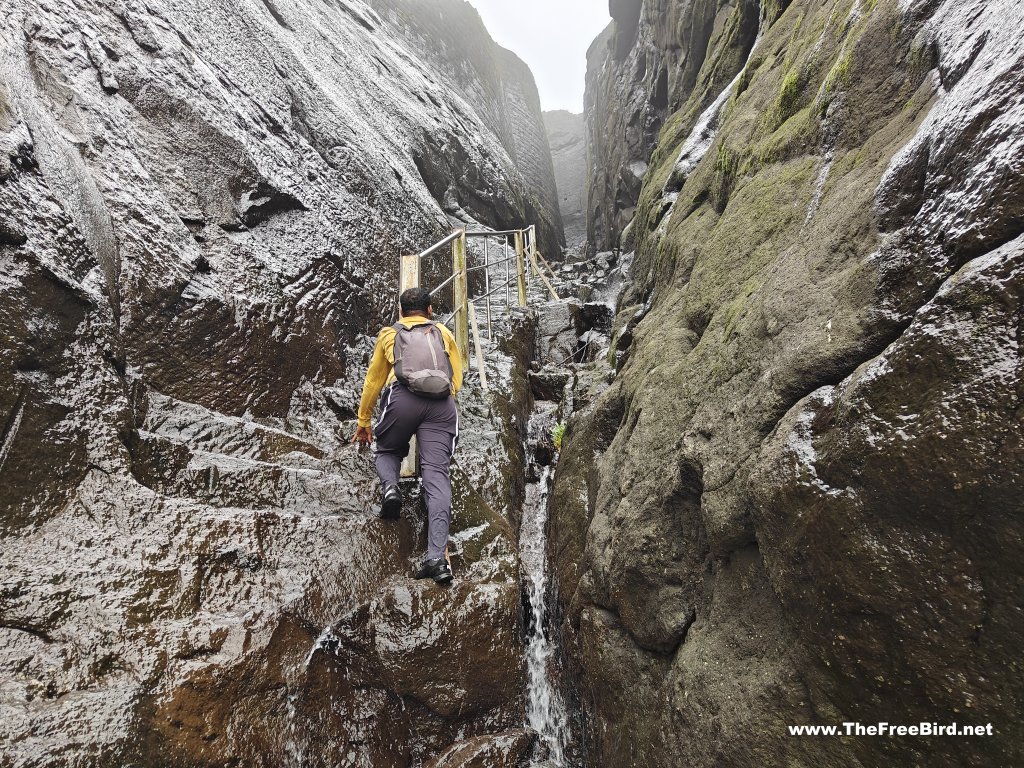
The climb became more interesting as we finally crossed the stairs and reached the last part of the climb near the main entrance. Since the British had blown off the stairs this last climb has turned into a rock patch of sorts but has proper grips for hand as well as feet. The walls of this gully clearly shows marks of the earlier staircase. The rectangular scars on the walls are where the original stair case existed. The rope tied is very useful for climbing during monsoon. In summer one can easily climb even without the rope.
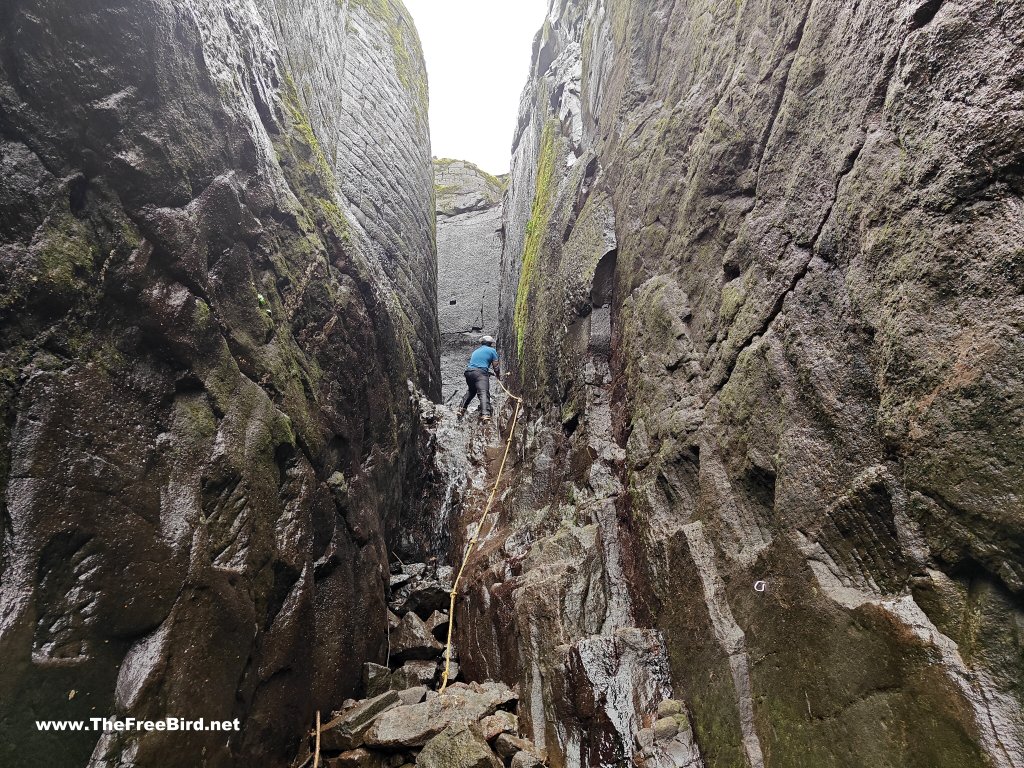
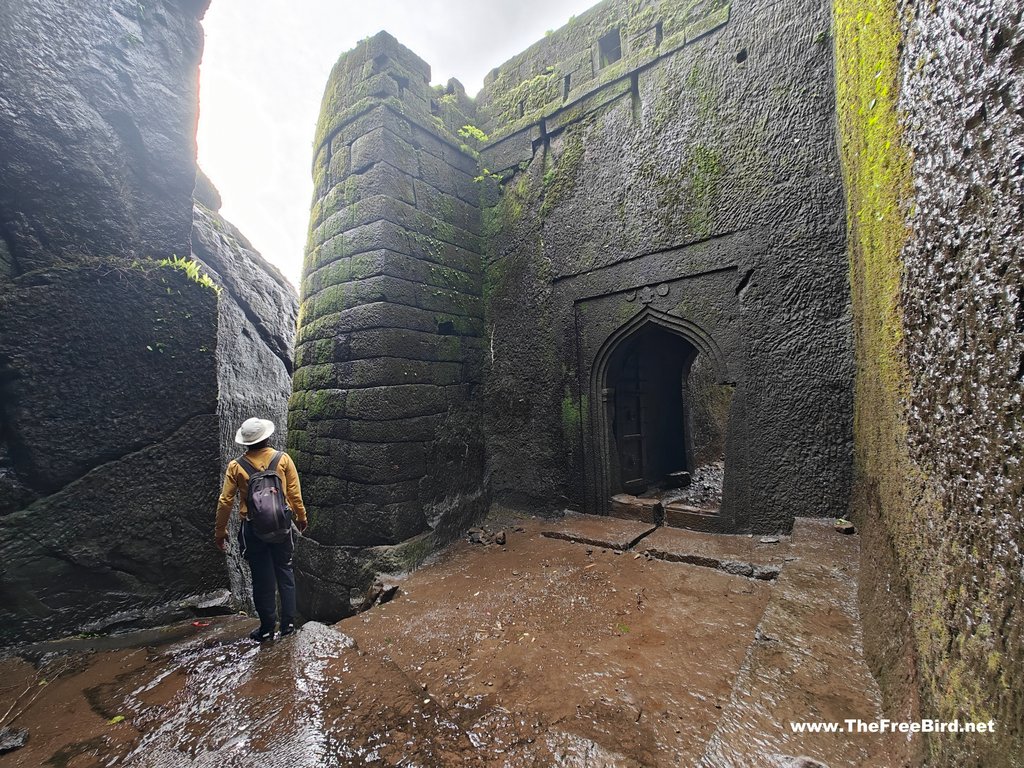
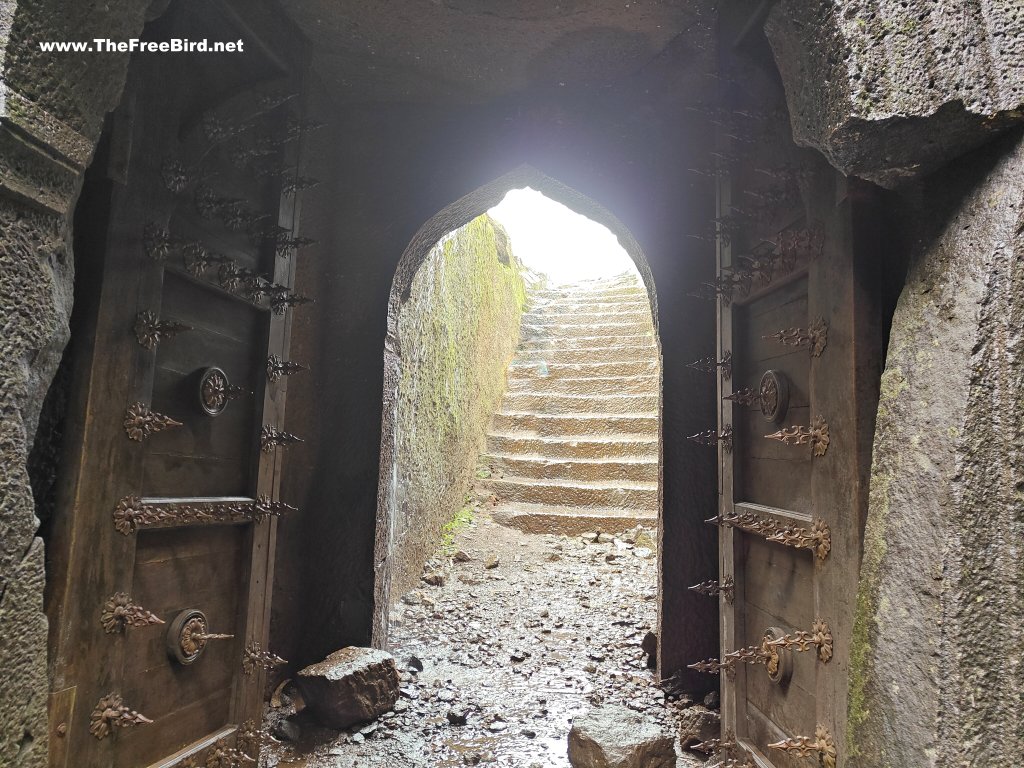
Imagine this, the entire entrance has been carved out of one single rock with such precision using just hammers & chisels. Having seen 100’s of forts I still get awestruck about the skills our ancestors had. The main door has a carved sun, moon & a holy pot / kalash. The entrance leads to a flight of stairs to the top.
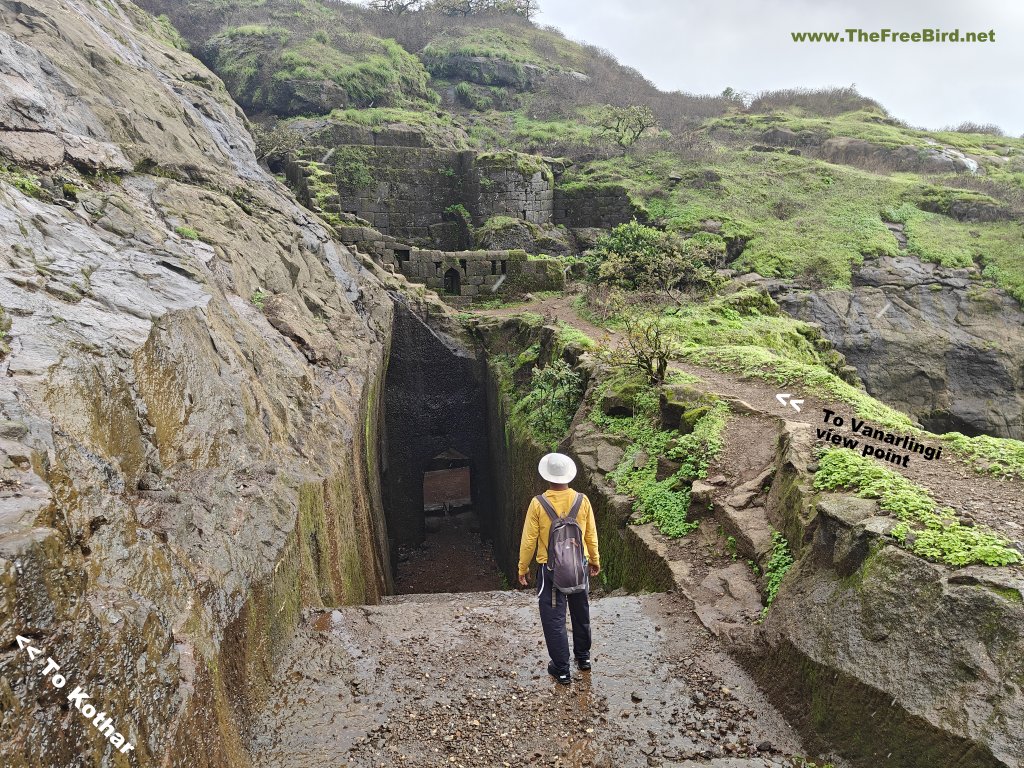
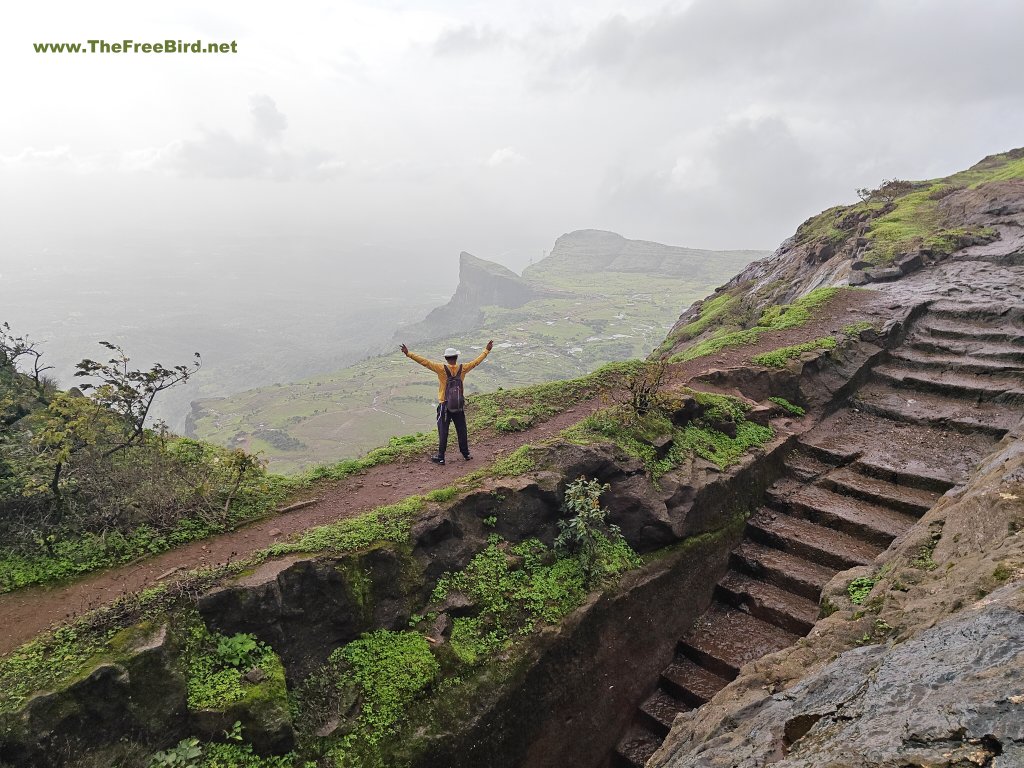
Jivdhan fort had clouds at top since morning , but as soon as we reached the top clouds vanished partially and the mighty Naneghat plateau became visible. Would be better if there were no clouds at all but then it would be too much of a ask from nature god. As we were running late we quickly moved to the south of the fort to see the mighty Vanarlingi pinnacle
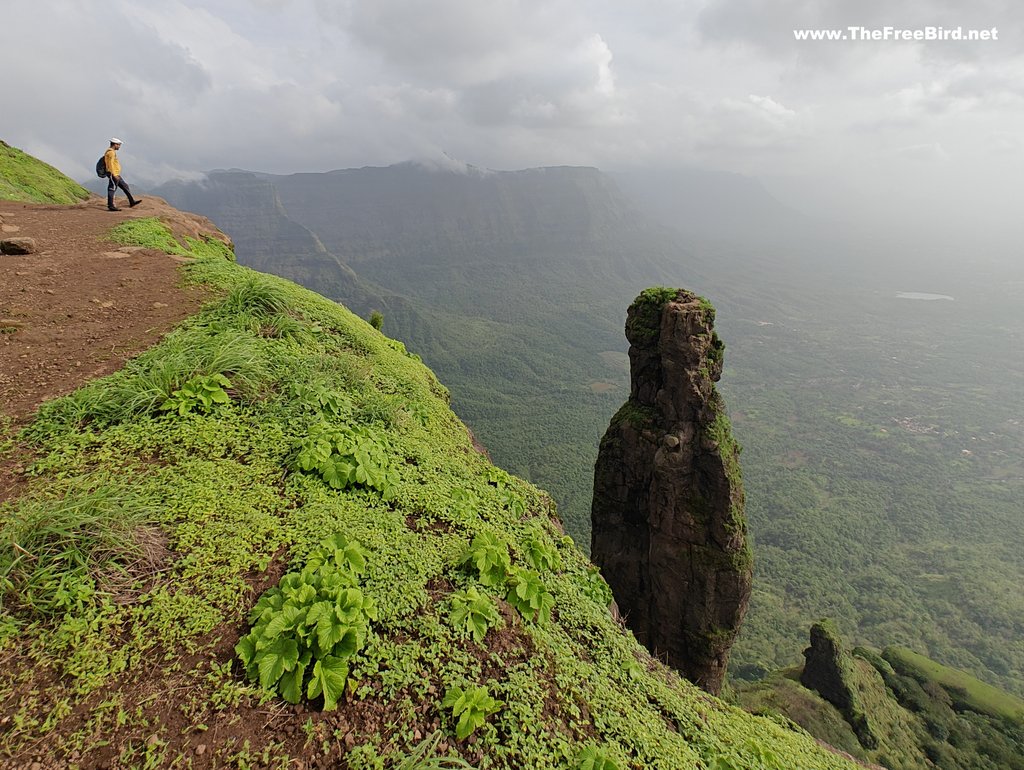
Varalingi sulka is a huge pinnacle and is climbed by mountaineers using rock climbing equipments. In the pic above where my friend is standing there are few nails drilled into the rock bed which is used for tying ropes while the other end is tied on top of the pinnacle creating a zip line to cross it- a daring adventure which you must attempt while you are still young and energetic. The clouds had cleared up just for us as we got tremendous views of Konkan. We climbed to top for even better views
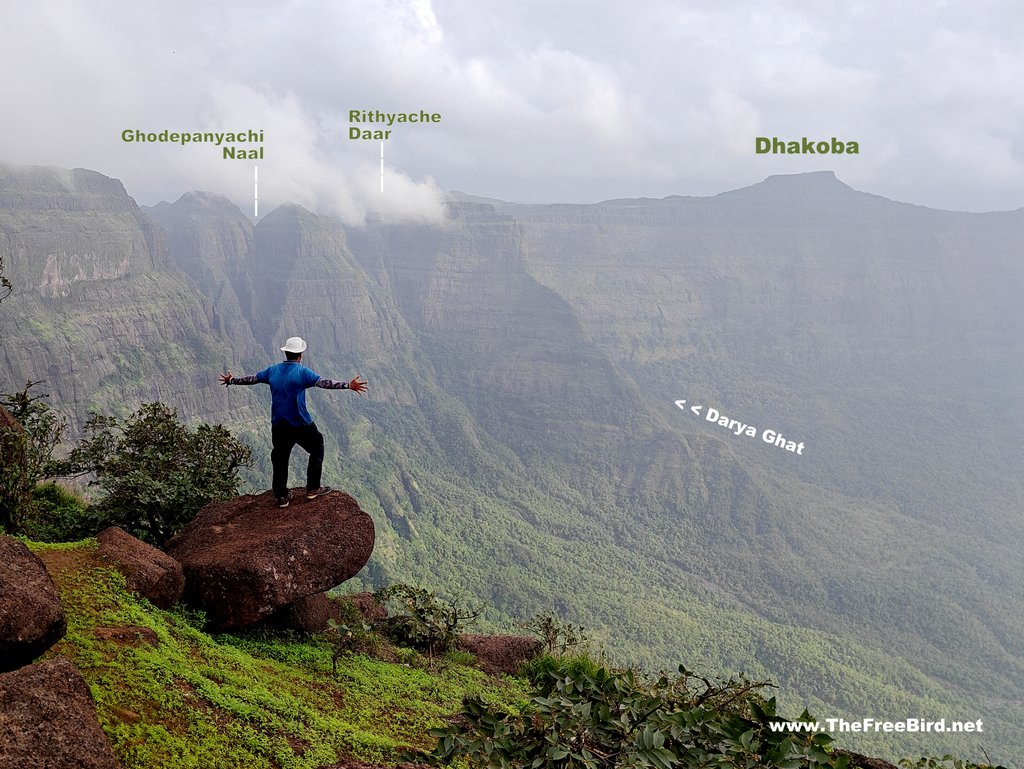
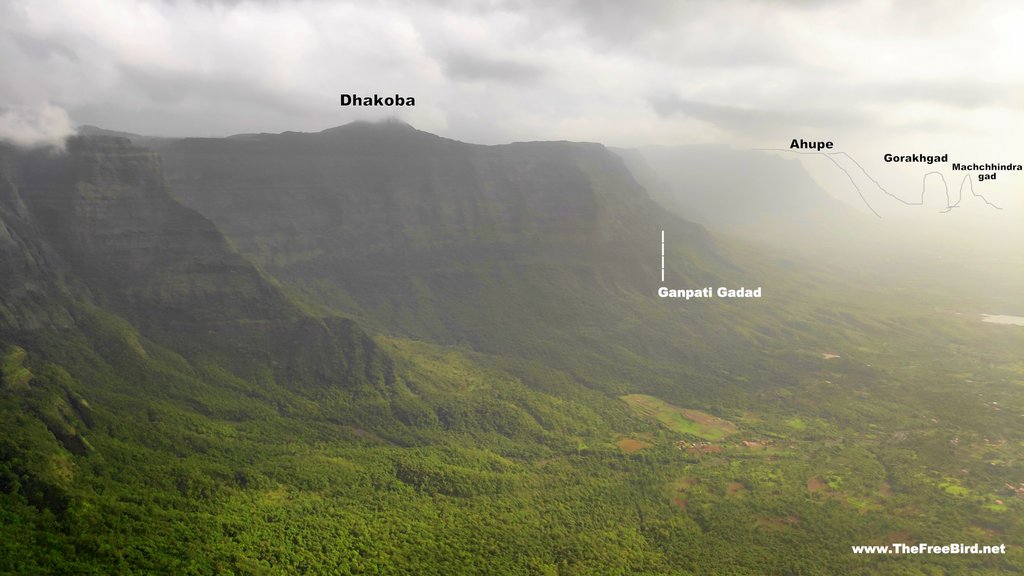
These places would be point of focus for upcoming treks probably in winter. The wind here at the southern top was so soothing as I just sat here taking in the view. At the top there are remnants of samadhi and a mandir of Jivai devi. Taking quick blessing we headed on the other side of the fort towards Junnar darwaja to see the Dhanya kothar ( grain storage ). The Kothar is a huge one with the first two rooms being constructed by square stones while the internal room has been carved into the rocky slope. The internal rooms are still dry & clean while the outer ones have started to leak due to neglect but still remains to be the most intact structure on Jivdhan.
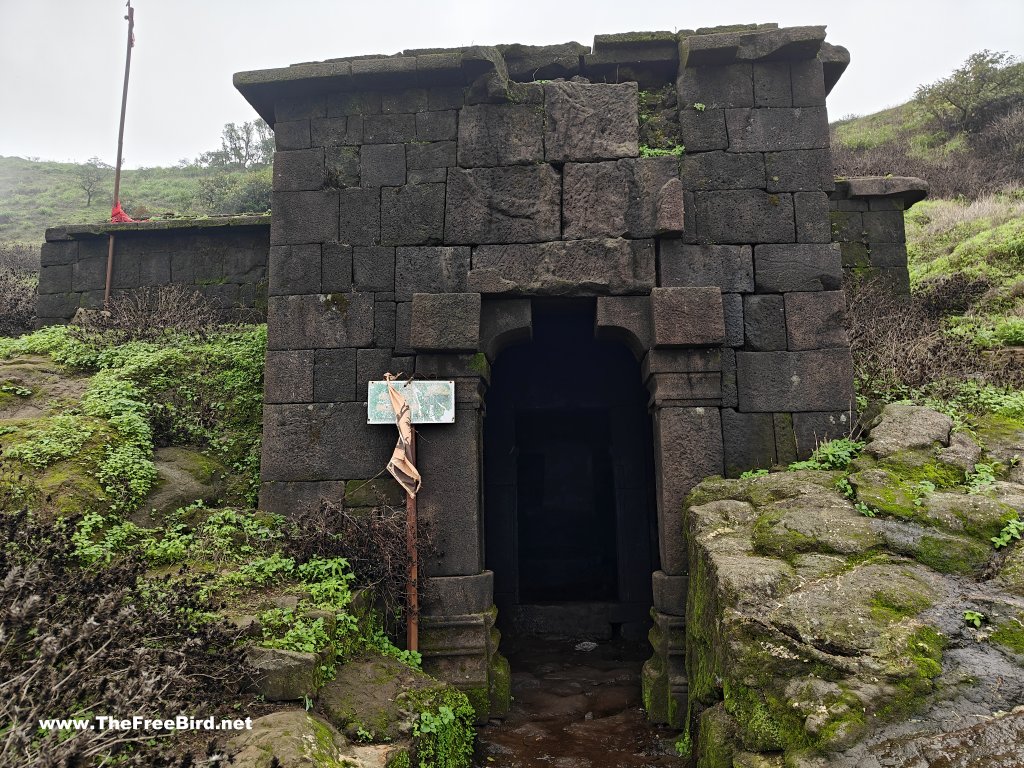
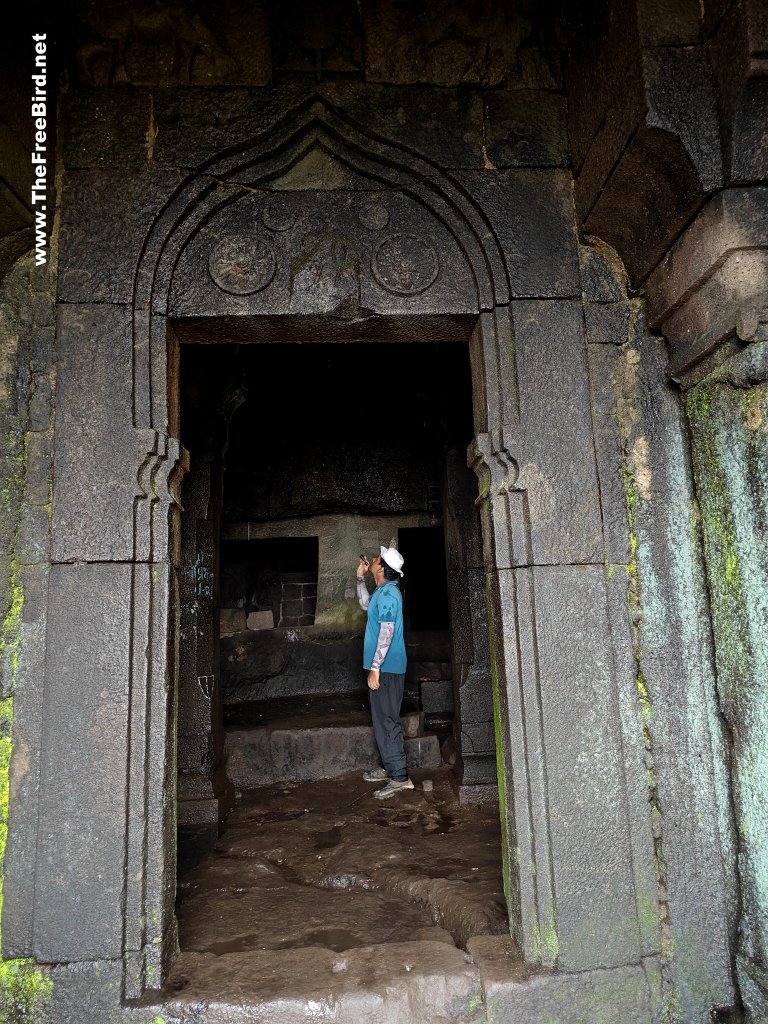
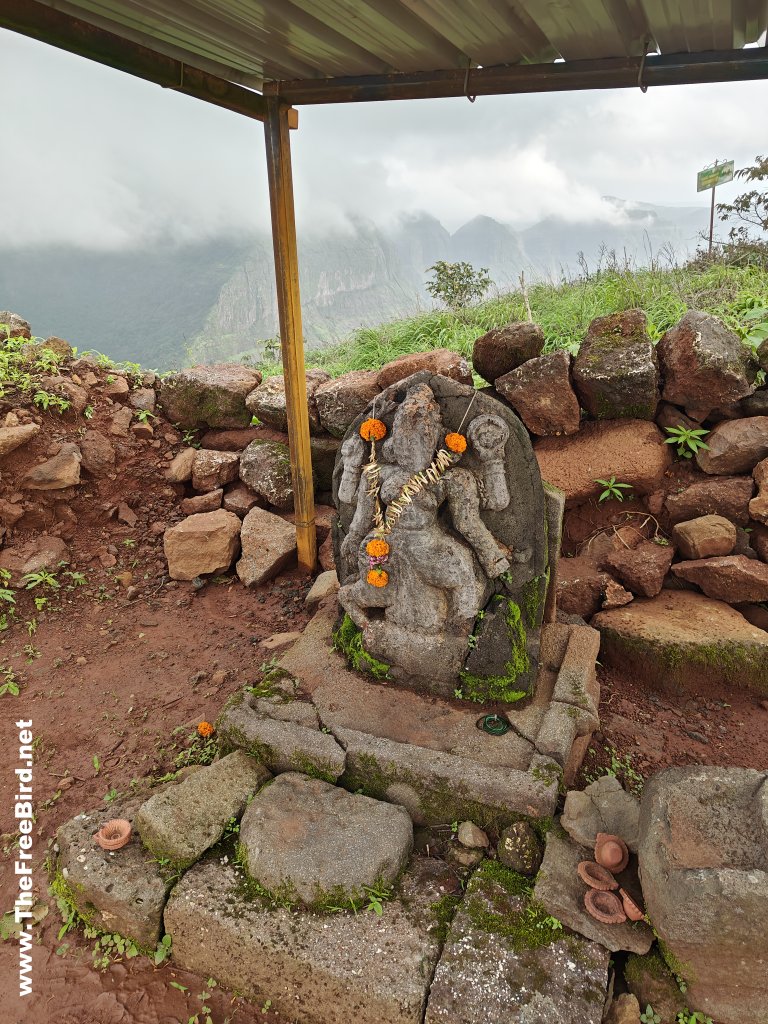
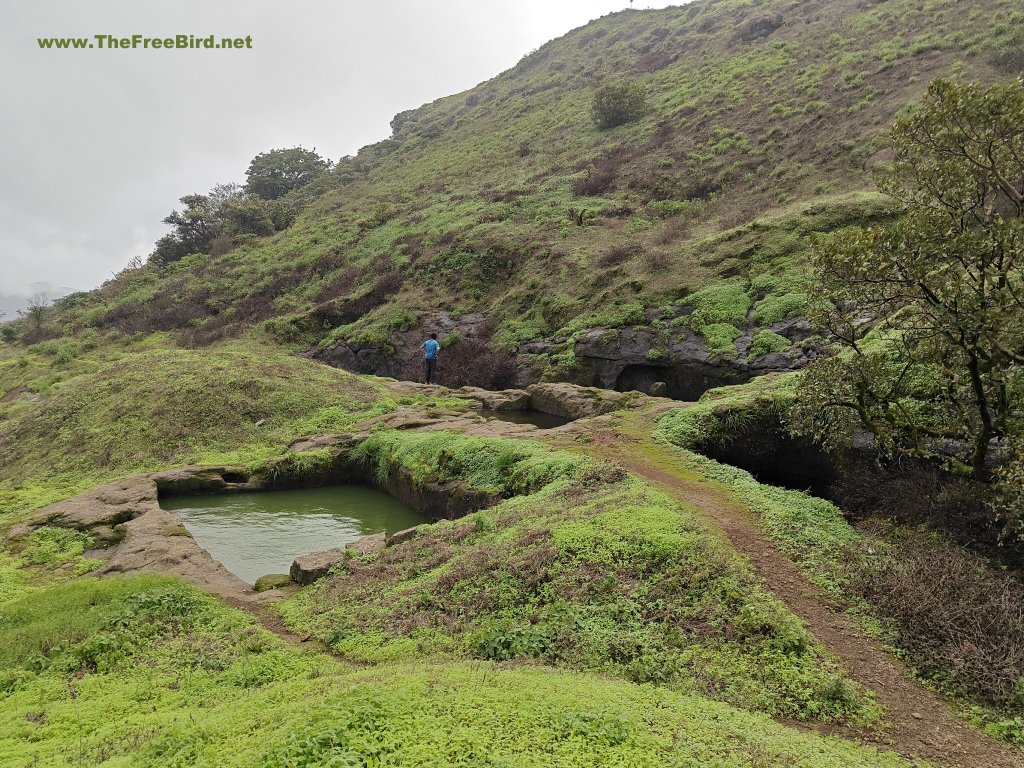
Towards the Junnar darwaja there are few more remains , more like just heaps of stones. Junnar darwaja is the other entrance of the fort, stairs to which were also blown off by the British in 1818. This is the quickest route from Ghatghar village. The stairs are similar to the Kalyan darwaja route but the blown off parts are much difficult to navigate. However 2 new ladders have been placed for easy access. Junnar darwaja has vast expanse of land in front of it making it easier to keep track of enemy movement
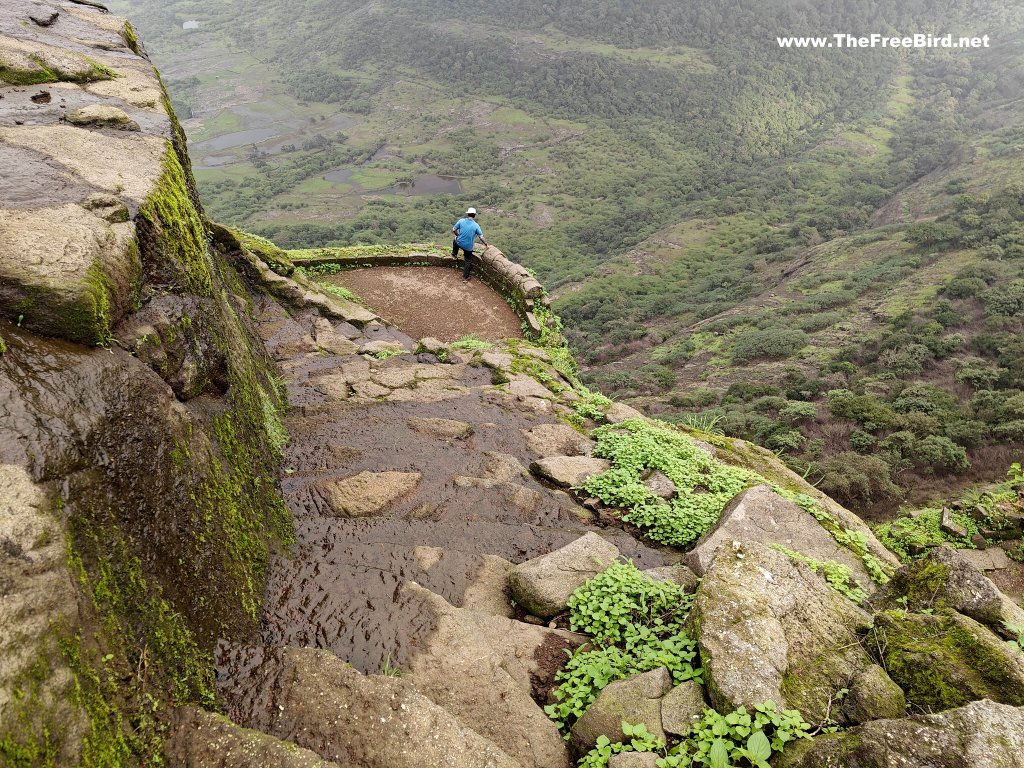
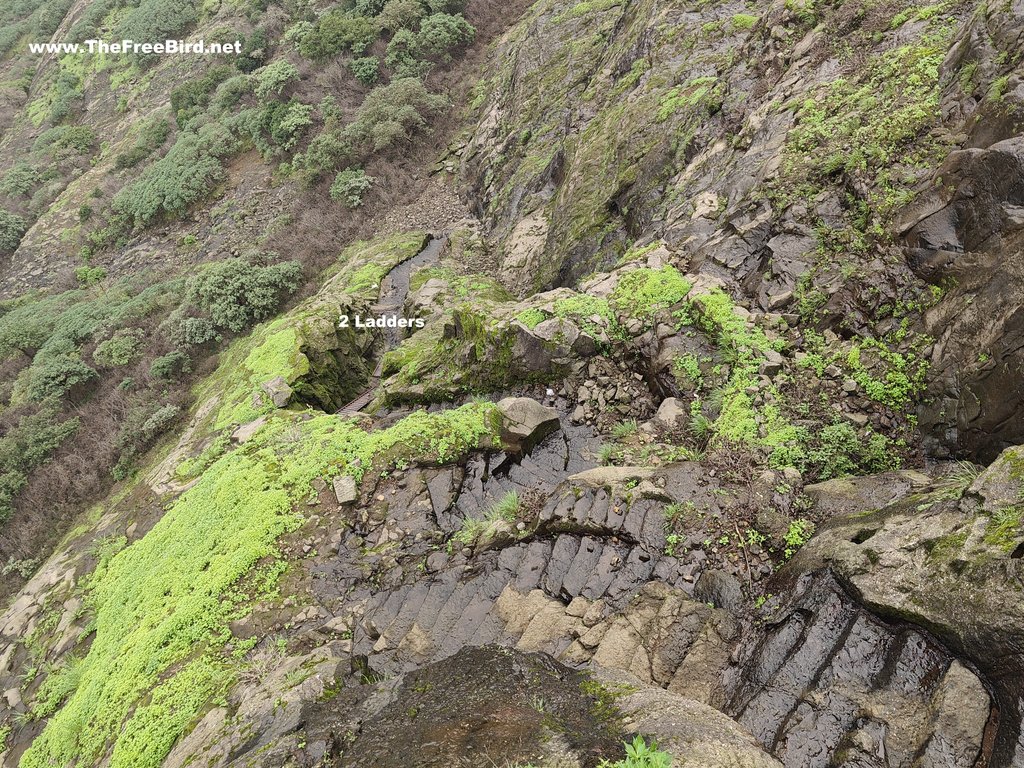
At the start of these stairs seems to be the entrance arch which has fallen off over the course of time or just blown off. Broken or not the view from here is terrific with many hills & forts visible but were hidden by clouds at that time. Besides the stairs is a cave probably for the soldiers guarding this entrance
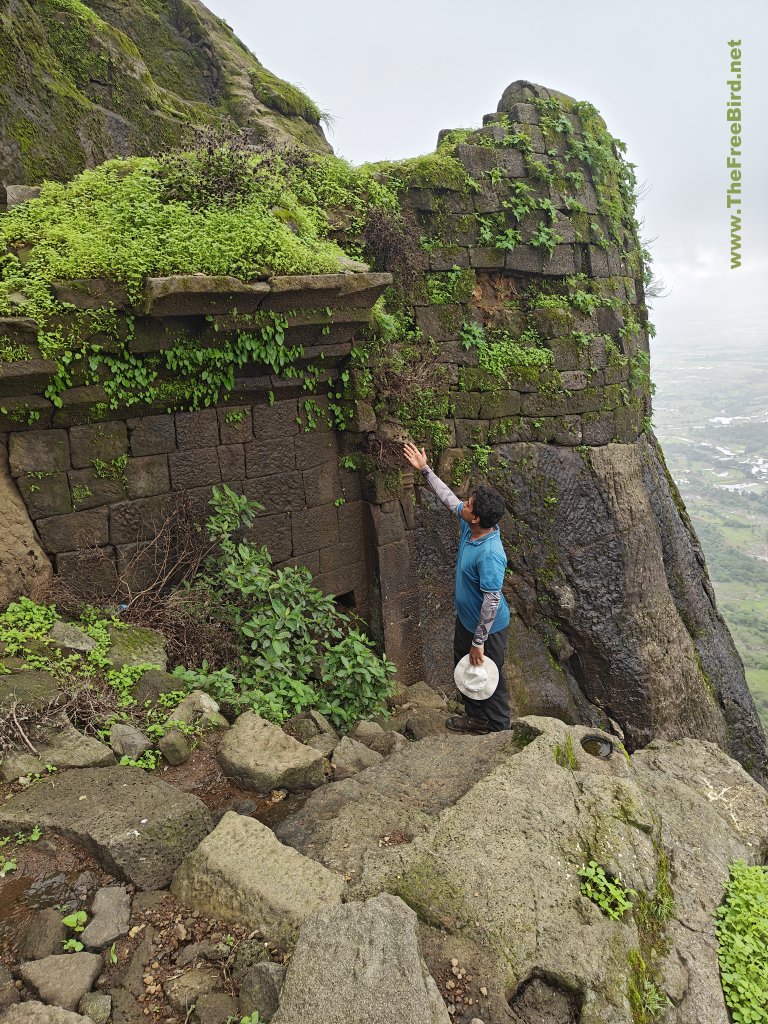
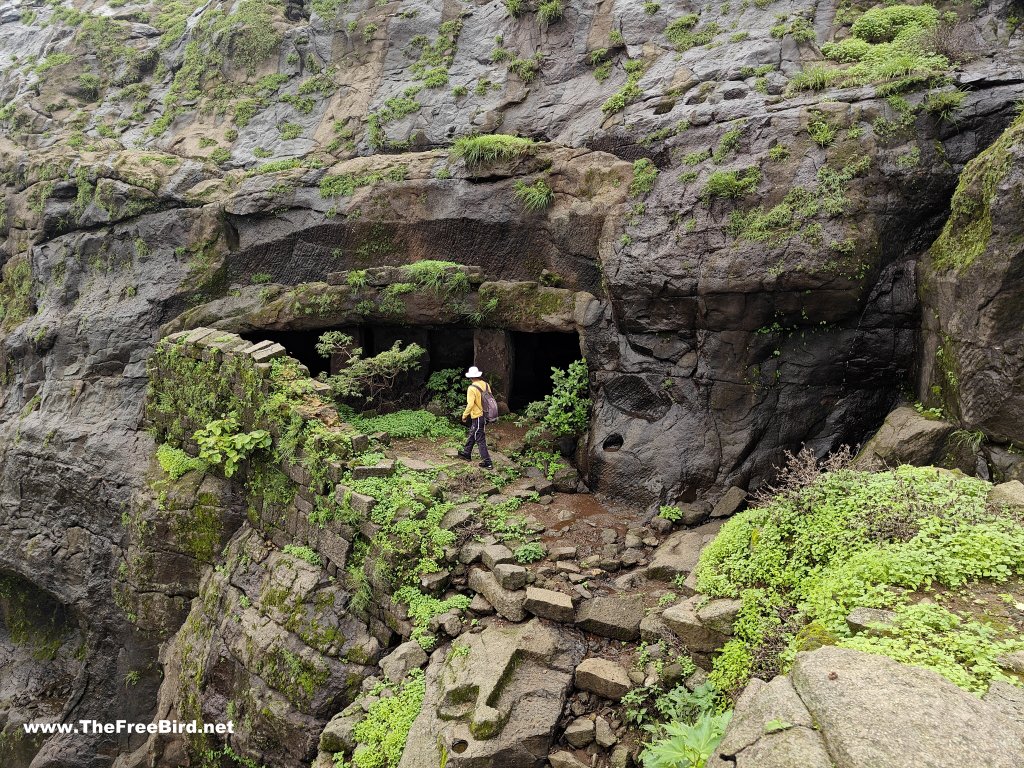
After enjoying the view from here we were to go to the north of Jivdhan to see fortifcation walls but clouds decided against it engulfing the entire fort within minutes. Since it was getting late and we had another 12kms to descend to reach bottom of Naneghat we started descending. Jivdhan fort has so much to offer with the historical significance , the adventurous climb & the view. I would definitely visit here in winter just to enjoy the southern view.
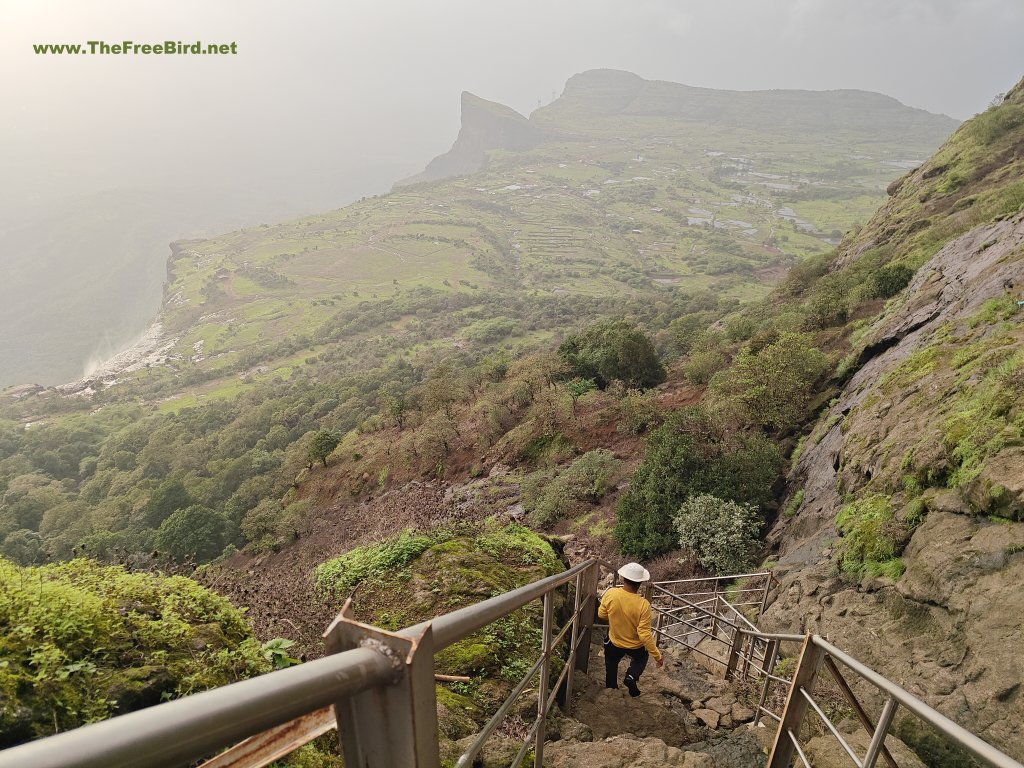
We descended rapidly to Naneghat in about 45 minutes , had some hot snacks, tea & started the Naneghat descend which took additional 90 minutes. Legs were aching and once I sat on my bike I felt so relieved with the cool wind in my hair. 2 more hours till I reach home sweet home.
Bye !!
That’s it for the Jivdhan fort trek blog.
If you have any doubts add a comment at the end of this post or reach out to me on my social media channels(at the end of this page). I also create ambience sahyadri videos on youtube.

TREKS NEAR MUMBAI & PUNE
expand for individual treks +
Waterfalls
Easy treks near mumbai- pune
Easy treks near Lonavala
Treks near kasara & nashik
Treks near Malshej
Konkan sea forts
Difficult treks
Offbeat
Matheran trekking routes from:
If you have been trekking in sahyadris for a long time , upgrade your skills to climb Himalayas by training for mountaineering which includes rock climbing, ice climbing and all adrenaline pumping adventures we love. Here is a short intro for moving from trekking to mountaineering
SOULFUL TRAVELS
 TheFreeBird
TheFreeBird

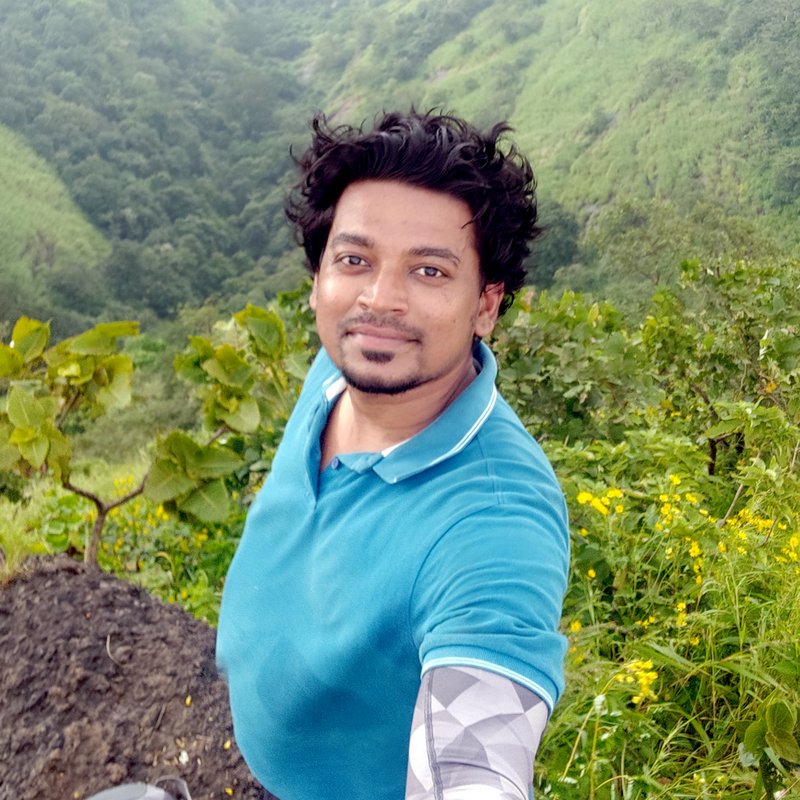
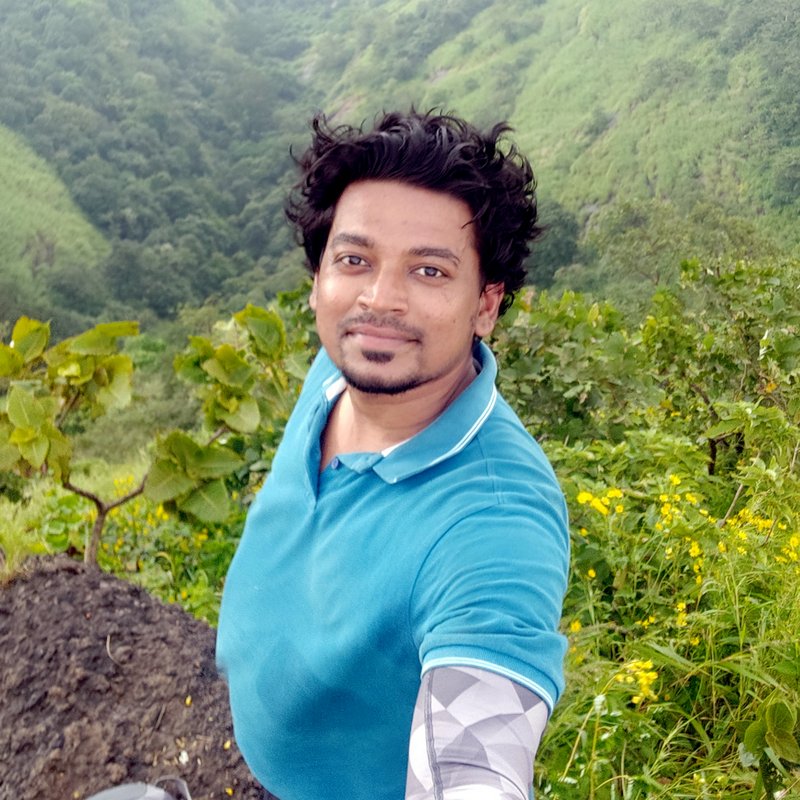

I am planning to do both the treks Naneghat & Jivdhan in same day. Can you help me with the time schedule i need to follow. I will be travelling from Palghar (136km 3.30hrs one way).
If you are using personal vehicle try to reach early by atleast 7-8 am to complete both and descend back early for the return journey. If using private try to align your travel using the transport I mentioned in the blog